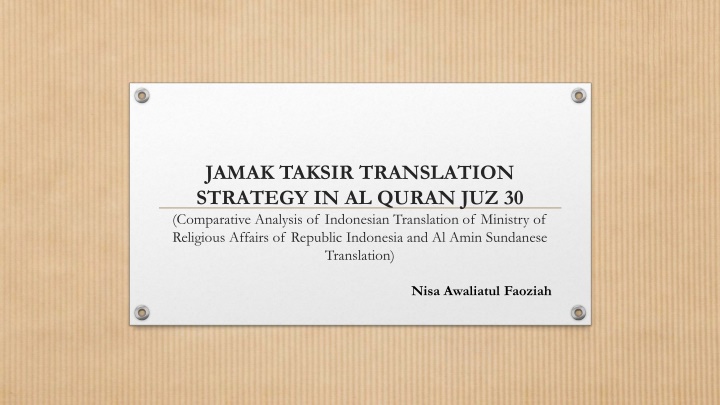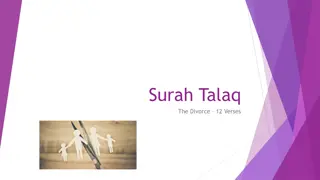
Translation Strategies for Jamak Taksir in Al-Quran Juz 30
Explore the translation techniques employed in translating Jamak Taksir in Al-Quran Juz 30 between Indonesian Ministry of Religious Affairs and Al-Amin Sundanese Translation, focusing on grammatical differences and cultural nuances to enhance understanding for native speakers.
Download Presentation

Please find below an Image/Link to download the presentation.
The content on the website is provided AS IS for your information and personal use only. It may not be sold, licensed, or shared on other websites without obtaining consent from the author. If you encounter any issues during the download, it is possible that the publisher has removed the file from their server.
You are allowed to download the files provided on this website for personal or commercial use, subject to the condition that they are used lawfully. All files are the property of their respective owners.
The content on the website is provided AS IS for your information and personal use only. It may not be sold, licensed, or shared on other websites without obtaining consent from the author.
E N D
Presentation Transcript
JAMAK TAKSIR TRANSLATION STRATEGY IN AL QURAN JUZ 30 (Comparative Analysis of Indonesian Translation of Ministry of Religious Affairs of Republic Indonesia and Al Amin Sundanese Translation) Nisa Awaliatul Faoziah
Abstract Differences in grammatical structure between Arabic as the source language and Indonesian as well as Sundanese as the target language requires translator to determine the appropriate translation strategy to create a more natural translation result that can be easily understood by the native speaker of the target language. In Arabic, there is a form of word called jamak taksir. jamak taksir are Arabic words that have many patterns and it is sometimes difficult to distinguish between pattern of these word and others because the pattern of jamak taksir is similar to other patterns such as mashdar or isim fail. In this study, the researcher examined the translation strategy used to translate appraisers of the Quran juz 30 in the Indonesian translation Quran by Ministry of Religious Affairs of Republic Indonesia and Sundanese translation Quran by Al Amin. This research was conducted using a qualitative descriptive approach with an embedded research method. The result showed that in both of the Quran translations, there are several techniques used to translate jamak taksir. Those are: literal, description, general equivalence, transposition, and adaptation translation. While the most frequently used technique in the two Quran translations is a literal translation technique, which indicates that the translations highly emphasized on the source language. Keyword: jamak taksir, translation technique
Research Problem Background Lason in Al-Farisi (2017) translate means : 1. Studying the source language from the aspect of the lexicon, grammatical structure, communication situation and cultural context 2. Analyze the source language to get the meaning the author wants 3. Reproduce the meaning by using the lexicon, grammatical structure, and cultural context contained in the target language.
Research Problem Background Differences in grammatical structure as well as culture are aspects that are considered in translation, especially in jamak taksir. With that difference in grammatical structure, the author will discuss the jamak taksir pattern based on grammatical semantic analysis. This study will also discuss the translation strategies used by translators in translating jamak taksir in Al-Quran juz 30 using the Indonesian translation from the Ministry of Religious Affairs of Republic Indonesia. It will also be compared with the results of Al-Amin's Sundanese translation published by Dipenogoro.
how the jamak taksir is translated into Indonesian and Sundanese which have differences both in language characteristics, culture or grammatical arrangement. In this study, the researchers used the Indonesian translation of the Indonesian Ministry of Religious Affairs and the Sundanese translation of the Quran Al Amin published by CV Dipenogoro.
Grand Theory Molina and Albir (2002) suggest eighteen translation techniques that can be used by translators, including: 1. Borrowing Technique 2. Calque technique 3. Literature Techniques 4. Amplification Technique 5. Reduction Technique 6. Compensation Technique 7. Description Technique 8. Discursive Creation Technique 9. Common Equivalence Technique 10. Generalization Technique 11. Particularization Technique 12. Linguistic Compression Technique 13. Variation Technique 14. Dissipation Technique 15. Addition Technique 16. Shift Technique 17. Modulation Technique 18. Adaptation Technique
Research Result There are five translation techniques used in translating the jamak taksir in juz 30 in the Indonesian translation of the Al Quran and the Sundanese translation of the Al Amin, namely: literal translation techniques, description translation techniques, common equivalence translation translation techniques and adaptation translation techniques. techniques, transposition
Research Result Translation Technique Percentage in Indonesian Translation 57.83% 22.89% Percentage in Sundanese Translation 62.65% 19.23%. literal translation technique transposition translation technique common equivalence translation technique description translation technique adaptation translation technique 6.02% 4.82% 9.64% 8.44% 3.62% 4.82%
Research Result In the two translations of the Quran, the translators very much use literal translation techniques in translating the jamak taksir in juz 30, the percentage of use is 57.83% in the Indonesian Ministry of Religious Affairs Indonesian translation and 62.65% in the Sundanese translation of the Al Quran Al Amin. which means that the translation in the two Qur'ans emphasizes more on the source language.
Conclusion Based on the results of research and discussion of the translation strategy of juz 30 in the Ministry of Religious Affairs Of Indonesian translation and the Sundanese translation of the Al Quran Al Amin, it can be concluded that: 1. In both the Indonesian Ministry of Religious Affairs Indonesian translation and the Sundanese translation Al Amin, the translation puts more emphasis on the source language because of the large percentage of literal translation techniques used. 2. Adjustments were made for words that do not have equivalents in Indonesian and Sundanese with adaptation and description translation techniques. 3. Transposition translation techniques are mostly used to adjust the different grammatical arrangements between Arabic, Sundanese, and Indonesian.


